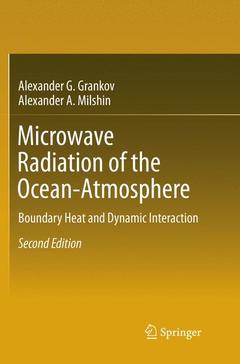Description
Microwave Radiation of the Ocean-Atmosphere (2nd Ed., Softcover reprint of the original 2nd ed. 2016)
Boundary Heat and Dynamic Interaction
Authors: Grankov Alexander G., Milshin Alexander A.
Language: English
Subjects for Microwave Radiation of the Ocean-Atmosphere:
Approximative price 126.59 €
In Print (Delivery period: 15 days).
Add to cartPublication date: 03-2019
193 p. · 15.5x23.5 cm · Paperback
Approximative price 126.59 €
In Print (Delivery period: 15 days).
Add to cartPublication date: 12-2015
Support: Print on demand
Description
/li>Contents
/li>Biography
/li>Comment
/li>
An important object in the studies is the North Atlantic with emphasize on the areas with high midlatitude cyclon activity: here the main results have been obtained by combining data from the vessel experiments NEWFOUEX-88, ATLANTEX-90 and the data of microwave radiometers from the DMSP and EOS Aqua satellites.
The role of vertical turbulent and horizontal advective heat transfer in forming interrelations between the brightness temperature of the system ocean-atmosphere and surface heat fluxes in the range of synoptic time scales is analyzed.
Special sections of the book describe some results of analysis of reaction of the system ocean-atmosphere on passing of the tropical cyclone Katrina (August 2005) in the Florida Strait as well as a behavior of the system in the period of a time preceding to origination the cyclone Humberto (September 2007) in the Mexico Gulf. The long-term goal of this research is the search for effects and regularities, which can explain the reasons for the tropical cyclones appearance. Some characteristics of the tropical cyclones (brightness temperature and heat contrasts, etc.) are compared with those for midlatitude cyclones.
At the same time as covering a key topic area with implications for global warming research, this text is also usefull to students who want to gain insight into application of satellite microwave radiometric methods for studying the air-sea interaction.
Key themes: microwave radiometry, air-sea interaction, midlatitude and tropical cyclones, atmosphere boundary layer, heat and momentum surface fluxes.
Parameters Accessible for the Satellite MCW Radiometric Means and Their Relations with the Ocean-Atmosphere Interaction.- Modeling of the SOA MCW and IR Radiation Characteristics and Their Relations with the Surface Heat Fluxes at the Synoptic Time Scales.- Search of Direct Relations Between Heat Fluxes and Parameters Associated with the SOA Brightness Temperature.- Influence of the Vertical Heat Transfer on Relations Between the SOA MCW and IR Radiation Intensity and the Surface Heat Fluxes (Modeling).- Influence of the Horizontal Heat Transfer in the ABL on Relations Between the SOA Brightness Temperature and the Surface Heat Fluxes (Modeling).- Experimental Studies of Relations Between the SOA Radiation and Heat Characteristics in the Synoptic Range of Time Scales.- Seasonal and Interannual Changeability of Heat Fluxes in the North Atlantic as Seen from the SSM/I Radiometer.- Fluxes of Sensible, Latent Heat, Impulse, and Atmosphere Water Vapor over North Atlantic from the EOS Aqua AMSR-E Radiometer.- Analysis of Dynamics of the SOA Parameters in Areas of Activity of the Tropical Cyclones.- Comparative Analysis of the Prestorm Situations in the Florida Straight and Golubaya Bay in the Black Sea.- Modern Satellite MCW Radiometric Means for an Analysis of the Ocean-Atmosphere Interaction.- Appendix 1.- Appendix 2.- Key Terms and Abbreviations.- Index.
Alexander G. Grankov received his PhD at the Kotel’nikov Institute of Radio Engineering and Electronics, Russian Academy of Sciences (IRE RAS), Fryazino Department (2002), where he is currently the head of the laboratory. He has a wide experience in remote sensing of the ocean and land covers from aircrafts and satellites, gained in numerous national and international aerospace experiments. Study of the intercommunication between natural microwave radiation and heat processes in the air-water interface is the specific and important topic of his activity. He is a member of the Popov Society for Radio Engineering and the author of over 200 scientific publications.
Alexander A. Milshin is a principal investigator of Kotel’nikov Institute of Radio Engineering and Electronics, Russian Academy of Sciences, Fryazino Department, and the JSC "Research & Production Corporation "Istok". He has a great experience in remote sensing of the ocean and land covers, and in processing microwave radiometric measurement data from satellites and aircrafts, acquired in numerous national and international aerospace experiments. He is a member of Popov Society for Radio Engineering and the author of 200 scientific publications.
This book provides readers insight into the application of satellite microwave radiometric methods for the study of the system ocean-atmosphere (SOA) interaction. It discusses the influence of the horizontal heat transfer in the atmospheric boundary layer (ABL), its temperature, humidity regime and energy exchange with the ocean surface as well as corresponding SOA brightness changes
Researches effects and regularities which can explain the behavior of the SOA heat and radiation characteristics at the stages of origin and development of tropical cyclones
Some topics of this book can have implications for research of the weather inter- and intra annual changes in the West Europe
Includes supplementary material: sn.pub/extras




